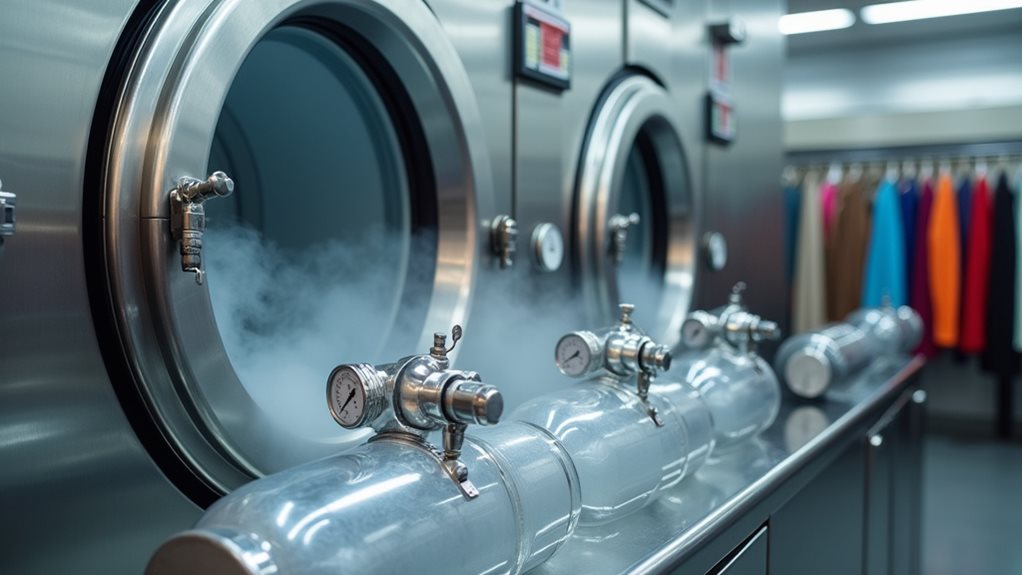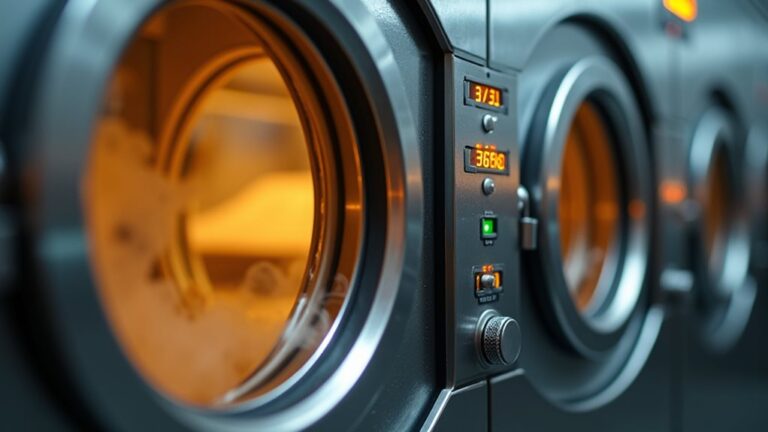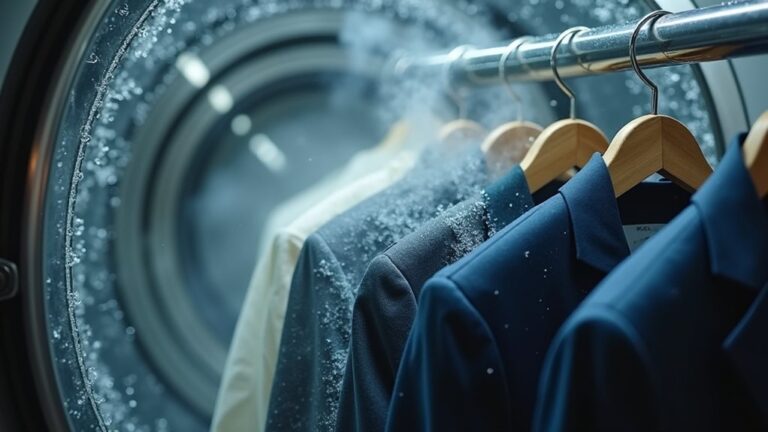When you drop off your favorite silk blouse at the dry cleaner, it doesn’t actually get “dried” in the traditional sense—instead, it’s bathed in chemical solvents like perchloroethylene that dissolve oil-based stains without using water. Your garments get inspected first, pre-treated for stubborn spots, then tumbled in these non-polar solvents that preserve delicate fabrics while lifting away grime that regular detergent can’t touch, and there’s so much more happening behind those curtains.
What Is Dry Cleaning and How Does It Differ From Regular Washing
Unlike regular washing that uses water and detergent, the dry cleaning process relies on chemical solvents, primarily perchloroethylene, to clean your clothes without saturating delicate fabrics.
These specialized dry cleaning machines circulate non-polar solvents that dissolve oil-based stains and dirt without the harsh agitation of traditional washing.
This cleaning process preserves your garment’s shape, texture, and integrity while effectively removing stubborn stains that water-based methods simply can’t tackle.
The process typically involves pre-treating stains, immersing clothes in the solvent bath, followed by drying and pressing to restore the garment’s original appearance.
The Chemical Solvents Used in Professional Dry Cleaning
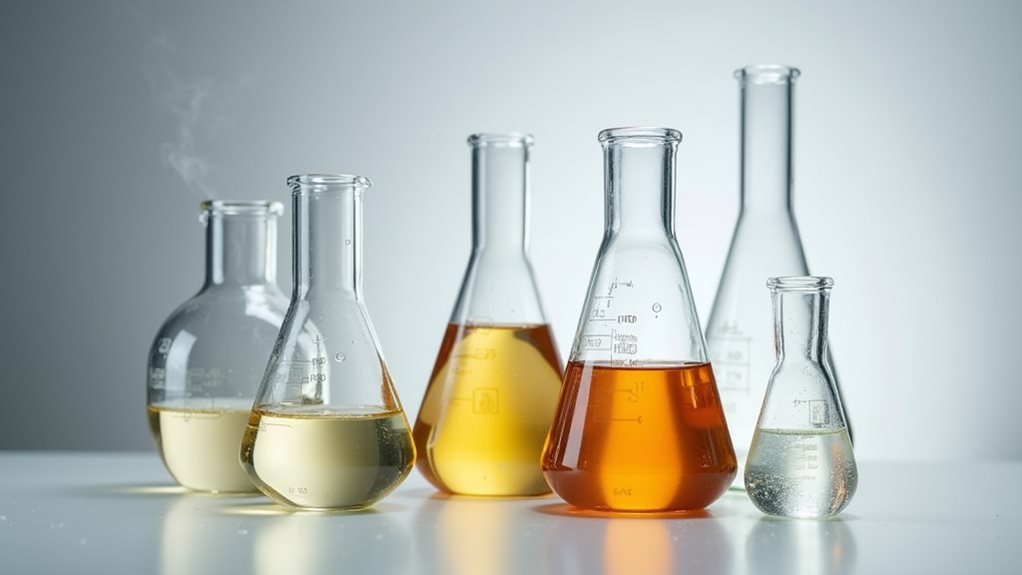
When you peek behind the curtain of professional dry cleaning, you’ll discover a fascinating world of chemical solvents that work like molecular matchmakers, pairing specific cleaning agents with your garment’s unique needs.
Perchloroethylene remains the industry workhorse, delivering exceptional cleaning efficiency while raising legitimate concerns about environmental impact.
Despite its cleaning prowess, perchloroethylene walks a tightrope between professional excellence and environmental responsibility in modern dry cleaning operations.
That’s why savvy cleaners are embracing alternative solvents like hydrocarbon solvent and liquid carbon dioxide – they’re gentler on both you and Mother Earth 🌍.
These non-polar solvents excel at dissolving stubborn stains without terrorizing delicate fabrics, unlike water which can shrink your favorite wool sweater into doll clothes.
Modern solvent recovery systems recycle 99.99% of these precious chemicals, proving that effective stains removal doesn’t require environmental sacrifice.
This chlorinated hydrocarbon became the industry standard because of its superior ability to dissolve oils and grease while being non-flammable and easily recycled within the cleaning process.
Step-by-Step Breakdown of the Dry Cleaning Process
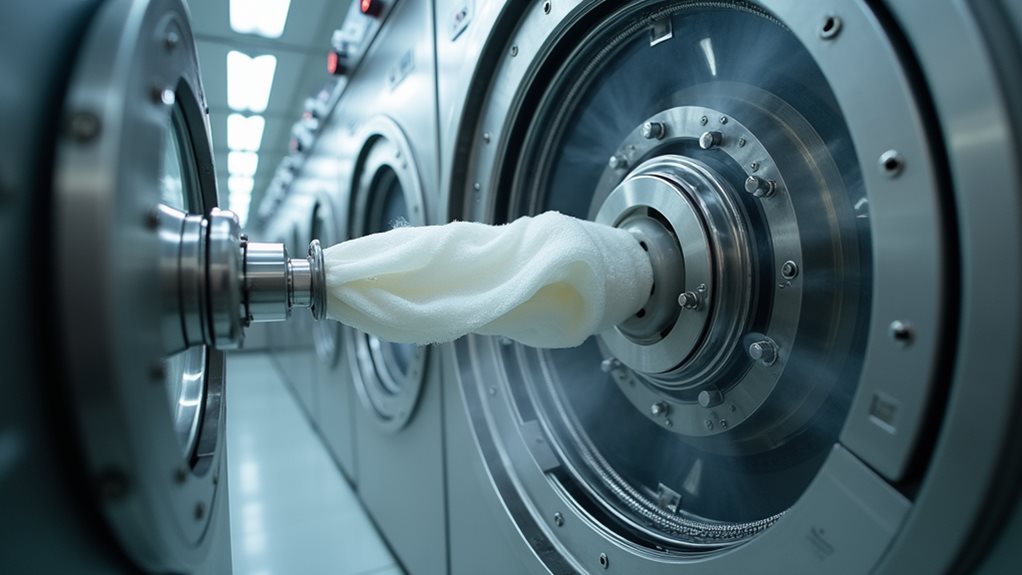
Behind those swinging doors at your neighborhood dry cleaner, there’s a carefully choreographed dance that transforms your stained silk blouse from disaster back to dazzling.
The dry cleaning process starts with inspection, where experienced eyes examine your garments for damage and identify stubborn stains that need special attention.
Next comes pre-treatment, where targeted formulas tackle everything from wine spills to water-based stains before the main event begins.
Your clothes then tumble gently in specialized cleaning machines filled with powerful solvents used instead of water, lifting away dirt without the harsh agitation that ruins delicate fabrics.
The most common solvent used is perchloroethylene, though many cleaners now offer eco-friendly alternatives like hydrocarbon or liquid CO2.
The finishing process follows, with careful steaming and pressing that restores your garment’s crisp appearance.
Finally, protective plastic bags shield your refreshed clothes during transport home.
Garment Inspection and Pre-Treatment of Stains

The real magic starts the moment your favorite outfit lands on that inspection counter, where trained professionals become detectives armed with magnifying glasses and decades of experience spotting trouble before it becomes permanent.
During garment inspection, they’ll carefully examine every inch for pre-existing damages, loose buttons, and mysterious stains you probably didn’t even notice. Each garment gets tagged for identification (because nobody wants to accidentally take home someone else’s power suit), while stains are categorized like a chemistry experiment – oil-based versus water-based requires completely different pre-treatment methods.
Specific stain removal agents are then applied to targeted areas, where they’ll sit patiently doing their molecular magic before the main cleaning process begins, guaranteeing maximum effectiveness in how professionals care for garments. This thorough pre-treatment process ensures that when garments enter the machine washing phase, the chemical solvents can work most effectively to dissolve remaining oils and dirt.
The Machine Cleaning and Solvent Recovery System
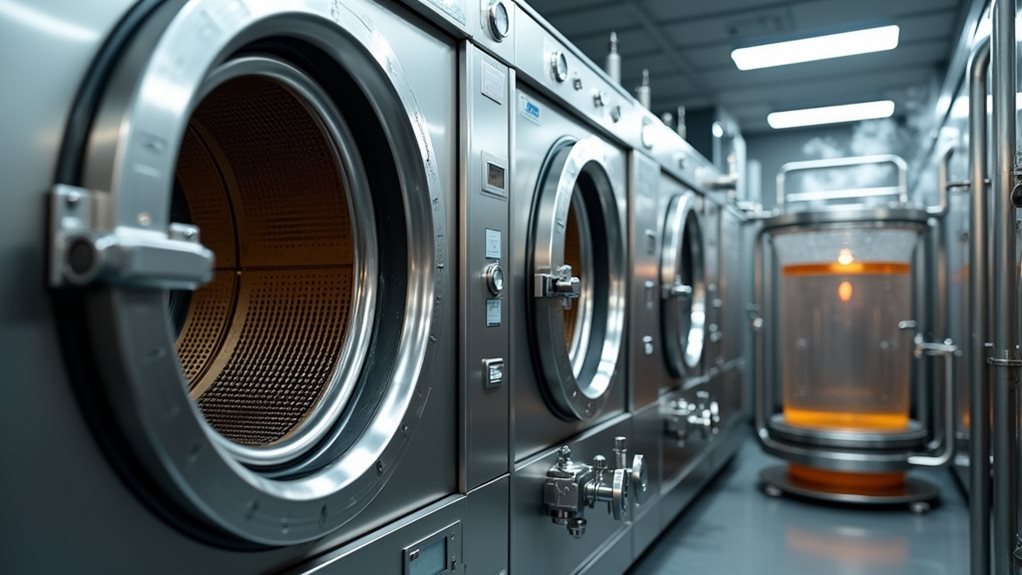
Envision this enormous washing machine that looks like it could launch into space, because that’s fundamentally what you’re looking at when dry cleaning professionals wheel your clothes toward those gleaming, industrial-sized chambers that cost more than most people’s cars.
These gleaming industrial chambers cost more than most cars yet operate like spacecraft designed exclusively for your delicate garments.
The dry cleaning machine operates like a high-tech marvel, using perchloroethylene or environmentally friendly solvents instead of water to preserve your garments’ integrity.
Here’s how the cleaning process works:
- Solvent circulation – Your clothes tumble in liquid solvent for 8-15 minutes
- Extraction phase – The extractor removes solvent from garments efficiently
- Recovery system – The solvent recovery system captures 99.99% of used solvent
- Purification – Built-in filters clean the solvent for reuse
This cleaning method achieves an impressive solvent recovery rate while protecting delicate fabrics. The solvents effectively dissolve oils, greases, and other substances that water cannot remove, making this process particularly valuable for maintaining garment quality.
Post-Cleaning Treatment and Finishing Techniques

Once your garments emerge from their solvent bath looking refreshed but slightly rumpled, they’re not quite ready for your closet yet—think of this stage like getting out of a relaxing spa treatment but still needing that final touch to look absolutely stunning.
The post-cleaning treatment begins with a thorough final inspection, where technicians examine every inch for stubborn stains that might’ve survived the chemical assault.
Next comes steaming for wrinkle removal, which freshens the fabric appearance without the harsh pressure that could damage delicate materials.
Pressing follows using specialized equipment that restores your suit’s sharp lines and your dress’s elegant drape.
During the drying phase, controlled heat and air circulation ensure any remaining solvent is completely removed from the fabric.
Finally, everything gets wrapped in plastic garment bags for protection, though prompt removal prevents moisture accumulation once you’re home.
Which Fabrics and Items Require Dry Cleaning Services
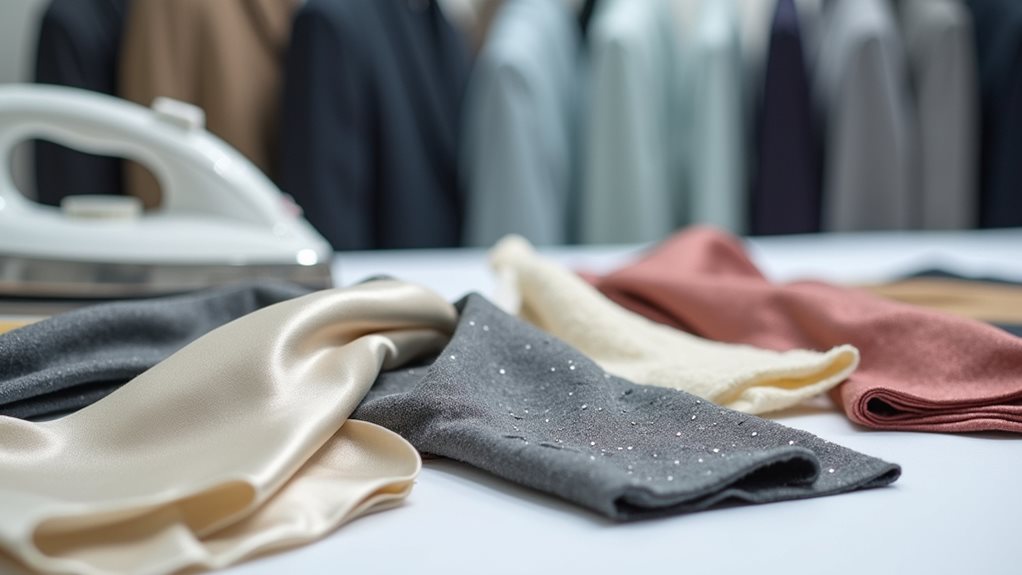
Wardrobe disasters teach us hard lessons, and I learned mine the expensive way when I tossed my favorite silk blouse into the washing machine like it was just another cotton t-shirt—spoiler alert: it wasn’t, and the results weren’t pretty 😅.
Now I’m much wiser about which fabrics need professional dry cleaning to avoid shrinkage and damage.
Here’s what always needs professional care:
- Sensitive fabrics like silk, velvet, and wool that can’t handle water’s harsh treatment
- Garments labeled “dry clean only” including formal wear and delicate specialty fabrics
- Items with stubborn oil stains that regular detergents can’t tackle effectively
- Upholstery and home items like drapes, leather, and suede requiring specialized handling
Dry cleaning uses chemical solvents instead of water to safely remove dirt and stains while preserving the fabric’s integrity, structure, and appearance.
Trust me, investing in proper dry cleaning beats replacing ruined clothes every time.
Environmental and Health Considerations in Modern Dry Cleaning
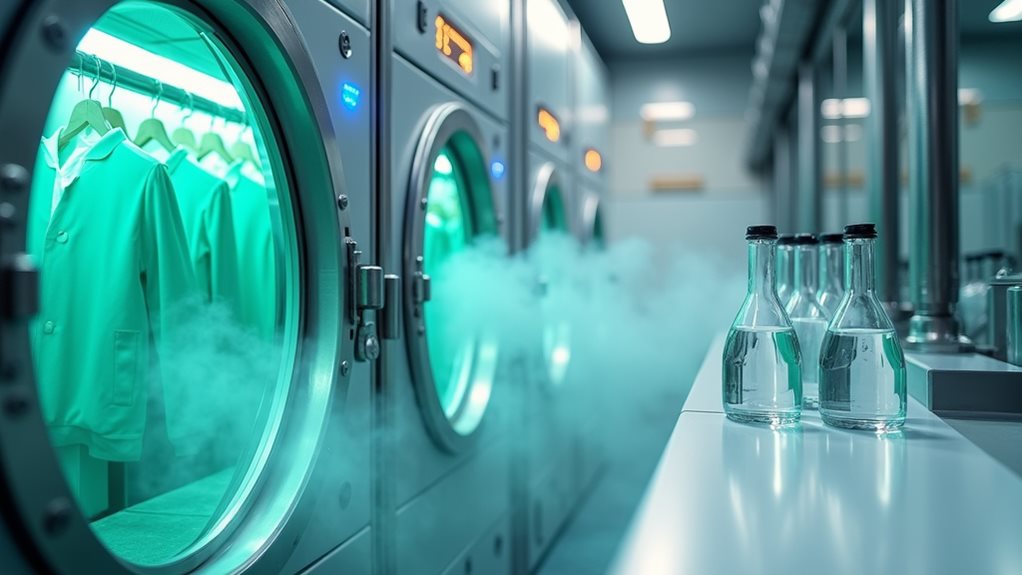
You’ve probably never thought about what happens behind those steaming machines at your local dry cleaner, but the truth is, traditional solvents like perchloroethylene have been quietly raising health concerns for workers and communities for decades.
The good news is that modern dry cleaning has evolved dramatically, with eco-friendly alternatives like liquid carbon dioxide and silicone-based solvents replacing those harsh chemicals that once made environmentalists break out in hives 😅.
Thanks to stricter EPA regulations and improved safety standards, today’s dry cleaning facilities are implementing better ventilation systems and recovery processes, which means you can get your favorite silk blouse cleaned without worrying about toxic residue lingering in your closet.
For consumers seeking the safest options, many cleaners now offer alternative methods such as wet cleaning and biodegradable solvents that pose minimal risk to both health and the environment.
Traditional Solvent Health Risks
While most of us don’t think twice about dropping off our favorite blazer at the local dry cleaner, the traditional solvents lurking behind those swinging doors have been quietly raising red flags among health experts for decades.
The culprit? Perchloroethylene, or “perc” as it’s known in the industry, which has earned the unsettling distinction of being classified as carcinogenic.
Here’s what you should know about these health risks:
- Occupational exposure affects workers through daily inhalation and skin contact
- Environmental impact includes groundwater contamination and air pollution
- Consumer risks arise from residual solvent traces on cleaned garments
- Neurological effects have been documented in long-term exposure studies
PERC residues can remain on freshly dry cleaned garments, making it especially important to allow items to air out before wearing, particularly for clothes worn close to the skin.
Thankfully, safer alternatives like liquid carbon dioxide are emerging, offering impressive cleaning performance while regulatory frameworks push the industry toward healthier solutions.
Eco-Friendly Alternative Methods
As the dry cleaning industry grapples with mounting health concerns, you’ll find yourself with more eco-friendly options than ever before, and honestly, it’s about time we’d safer alternatives that don’t make you wonder if your freshly cleaned suit comes with a side of carcinogens.
Wet cleaning uses biodegradable detergents instead of harsh chemicals, while liquid carbon dioxide cleaning employs pressurized CO2 as a non-toxic solvent – pretty cool, right?
Since the EPA banned perchloroethylene in residential facilities due to serious health risks, sustainable practices have flourished. Modern cleaners invest in energy-efficient machines that maximize solvent recovery, reducing waste considerably.
These greener technologies prove you don’t have to sacrifice quality for safety, giving us all better peace of mind. Hydrocarbon-based cleaners represent another eco-friendly alternative that effectively removes stains while maintaining the same level of garment care as traditional solvents.
Regulatory Safety Standards
Given the growing awareness of health risks in traditional dry cleaning, regulatory agencies have stepped up their game considerably, implementing stricter safety standards that protect both workers and consumers from harmful chemical exposure.
You’ll find that perchloroethylene, once the industry standard, now faces serious restrictions due to occupational exposure concerns and environmental impacts.
Here’s what regulatory frameworks are prioritizing:
- Phase-out mandates for perc in residential facilities, pushing businesses toward safer alternatives
- Worker protection protocols that limit exposure to dry cleaning chemicals through improved ventilation systems
- Environmental compliance standards that reduce toxic emissions from traditional solvents
- Innovation incentives encouraging adoption of eco-friendly solvents like liquid carbon dioxide
The dry cleaning industry is adapting, though sometimes reluctantly, because these regulations ultimately create healthier workplaces and communities for everyone involved.

